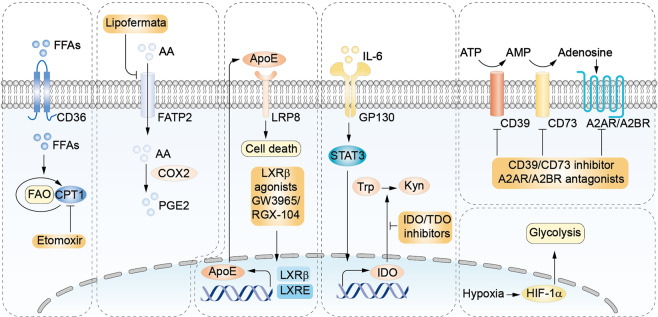Fig. 5.
Targeting MDSCs by interrupting their metabolism. MDSCs are characterized by high free fatty acids (FFAs) uptake and fatty acid oxidation (FAO). Carnitine palmitoyltransferase 1 (CPT1), the first rate-limiting enzyme in the FAO cycle, can be inhibited by etomoxir. FATP2 mediates the uptake of arachidonic acid (AA) which subsequently promotes the synthesis of PGE2 in MDSCs. Lipofermata selectively inhibits FATP2. LXR agonists promote the transcriptional upregulation of apolipoprotein E (ApoE) which subsequently reduces MDSCs survival by binding to low-density lipoprotein receptor-related protein 8 (LRP8) on MDSCs. IDO and tryptophan 2,3-dioxygenase (TDO) catalyze the first rate-limiting step in the conversion of L-tryptophan to L-kynurenine. IL-6 upregulates the transcription of IDO promoter in MDSCs through STAT-3 activation. IDO/TDO inhibitors attenuate the suppressive capability of MDSCs. Adenosine-generating axis and its receptor A2AR/A2BR are also metabolic targets to inhibit MDSCs. MDSCs exhibit upregulated glycolysis which is regulated by HIF-1α. CD36, fatty acid translocase; FATP2, fatty acid transport protein 2; LXR, Liver-X receptors; Trp, tryptophan; Kyn, kynurenine.

